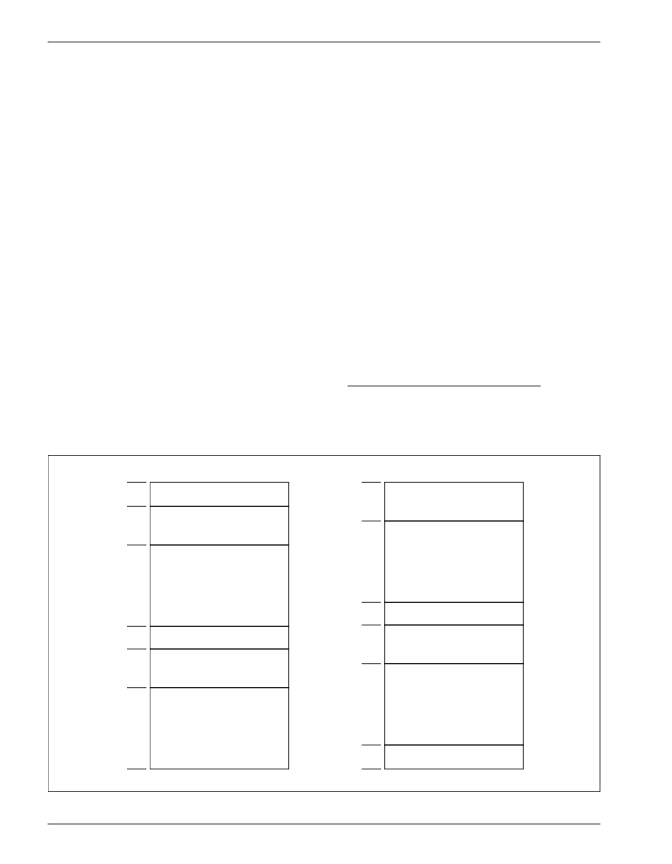- 您現(xiàn)在的位置:買賣IC網(wǎng) > PDF目錄382396 > PNX1300 (NXP Semiconductors N.V.) Media Processors PDF資料下載
參數(shù)資料
| 型號: | PNX1300 |
| 廠商: | NXP Semiconductors N.V. |
| 英文描述: | Media Processors |
| 中文描述: | 媒體處理器 |
| 文件頁數(shù): | 132/548頁 |
| 文件大小: | 6050K |
| 代理商: | PNX1300 |
第1頁第2頁第3頁第4頁第5頁第6頁第7頁第8頁第9頁第10頁第11頁第12頁第13頁第14頁第15頁第16頁第17頁第18頁第19頁第20頁第21頁第22頁第23頁第24頁第25頁第26頁第27頁第28頁第29頁第30頁第31頁第32頁第33頁第34頁第35頁第36頁第37頁第38頁第39頁第40頁第41頁第42頁第43頁第44頁第45頁第46頁第47頁第48頁第49頁第50頁第51頁第52頁第53頁第54頁第55頁第56頁第57頁第58頁第59頁第60頁第61頁第62頁第63頁第64頁第65頁第66頁第67頁第68頁第69頁第70頁第71頁第72頁第73頁第74頁第75頁第76頁第77頁第78頁第79頁第80頁第81頁第82頁第83頁第84頁第85頁第86頁第87頁第88頁第89頁第90頁第91頁第92頁第93頁第94頁第95頁第96頁第97頁第98頁第99頁第100頁第101頁第102頁第103頁第104頁第105頁第106頁第107頁第108頁第109頁第110頁第111頁第112頁第113頁第114頁第115頁第116頁第117頁第118頁第119頁第120頁第121頁第122頁第123頁第124頁第125頁第126頁第127頁第128頁第129頁第130頁第131頁當前第132頁第133頁第134頁第135頁第136頁第137頁第138頁第139頁第140頁第141頁第142頁第143頁第144頁第145頁第146頁第147頁第148頁第149頁第150頁第151頁第152頁第153頁第154頁第155頁第156頁第157頁第158頁第159頁第160頁第161頁第162頁第163頁第164頁第165頁第166頁第167頁第168頁第169頁第170頁第171頁第172頁第173頁第174頁第175頁第176頁第177頁第178頁第179頁第180頁第181頁第182頁第183頁第184頁第185頁第186頁第187頁第188頁第189頁第190頁第191頁第192頁第193頁第194頁第195頁第196頁第197頁第198頁第199頁第200頁第201頁第202頁第203頁第204頁第205頁第206頁第207頁第208頁第209頁第210頁第211頁第212頁第213頁第214頁第215頁第216頁第217頁第218頁第219頁第220頁第221頁第222頁第223頁第224頁第225頁第226頁第227頁第228頁第229頁第230頁第231頁第232頁第233頁第234頁第235頁第236頁第237頁第238頁第239頁第240頁第241頁第242頁第243頁第244頁第245頁第246頁第247頁第248頁第249頁第250頁第251頁第252頁第253頁第254頁第255頁第256頁第257頁第258頁第259頁第260頁第261頁第262頁第263頁第264頁第265頁第266頁第267頁第268頁第269頁第270頁第271頁第272頁第273頁第274頁第275頁第276頁第277頁第278頁第279頁第280頁第281頁第282頁第283頁第284頁第285頁第286頁第287頁第288頁第289頁第290頁第291頁第292頁第293頁第294頁第295頁第296頁第297頁第298頁第299頁第300頁第301頁第302頁第303頁第304頁第305頁第306頁第307頁第308頁第309頁第310頁第311頁第312頁第313頁第314頁第315頁第316頁第317頁第318頁第319頁第320頁第321頁第322頁第323頁第324頁第325頁第326頁第327頁第328頁第329頁第330頁第331頁第332頁第333頁第334頁第335頁第336頁第337頁第338頁第339頁第340頁第341頁第342頁第343頁第344頁第345頁第346頁第347頁第348頁第349頁第350頁第351頁第352頁第353頁第354頁第355頁第356頁第357頁第358頁第359頁第360頁第361頁第362頁第363頁第364頁第365頁第366頁第367頁第368頁第369頁第370頁第371頁第372頁第373頁第374頁第375頁第376頁第377頁第378頁第379頁第380頁第381頁第382頁第383頁第384頁第385頁第386頁第387頁第388頁第389頁第390頁第391頁第392頁第393頁第394頁第395頁第396頁第397頁第398頁第399頁第400頁第401頁第402頁第403頁第404頁第405頁第406頁第407頁第408頁第409頁第410頁第411頁第412頁第413頁第414頁第415頁第416頁第417頁第418頁第419頁第420頁第421頁第422頁第423頁第424頁第425頁第426頁第427頁第428頁第429頁第430頁第431頁第432頁第433頁第434頁第435頁第436頁第437頁第438頁第439頁第440頁第441頁第442頁第443頁第444頁第445頁第446頁第447頁第448頁第449頁第450頁第451頁第452頁第453頁第454頁第455頁第456頁第457頁第458頁第459頁第460頁第461頁第462頁第463頁第464頁第465頁第466頁第467頁第468頁第469頁第470頁第471頁第472頁第473頁第474頁第475頁第476頁第477頁第478頁第479頁第480頁第481頁第482頁第483頁第484頁第485頁第486頁第487頁第488頁第489頁第490頁第491頁第492頁第493頁第494頁第495頁第496頁第497頁第498頁第499頁第500頁第501頁第502頁第503頁第504頁第505頁第506頁第507頁第508頁第509頁第510頁第511頁第512頁第513頁第514頁第515頁第516頁第517頁第518頁第519頁第520頁第521頁第522頁第523頁第524頁第525頁第526頁第527頁第528頁第529頁第530頁第531頁第532頁第533頁第534頁第535頁第536頁第537頁第538頁第539頁第540頁第541頁第542頁第543頁第544頁第545頁第546頁第547頁第548頁

PNX1300/01/02/11 Data Book
Philips Semiconductors
7-22
PRELIMINARY SPECIFICATION
Graphics Overlay
The graphics overlay is enabled by the VO_CTL. OL_EN
bit. The graphics overlay is typically a software-generat-
ed graphic overlaid onto the output video image stream
The graphics overlay is either generated in YUV by the
DSPCPU or converted by the DSPCPU from an RGB to
a YUV overlay image. Because RGB-to-YUV conversion
can potentially lose information, this conversion is done
by the DSPCPU, because it has the most information
about how best to perform this conversion in the most ef-
fective manner.
The overlay height should be chosen such that the over-
lay does not vertically extend beyond the image area. A
height greater than this causes undefined results and
may result in vertical overlay wraparound.
Note: The emitted byte data rate is limited to 45% of the
SDRAM clock when overlays are enabled.
The YUV overlay logic assembles the U0, Y0, V0, Y1
bytes for a pair of YUV 4:2:2 pixels for both the main im-
age and the overlay image. The alpha bit for pixel 0 (the
LSB of the U0 byte of the overlay image) selects
ALPHA_ZERO or ALPHA_ONE as the alpha source,
and the alpha blend logic combines U0, Y0, and V0 from
the main and overlay images to generate the U0, Y0 and
V0 output values. The alpha bit for pixel 1 (the LSB of the
V0 byte of the overlay image) selects ALPHA_ZERO or
ALPHA_ONE as the alpha source for blending the Y1
pixels to generate the Y1 output value. The alpha blend-
ed U0, Y0, V0 and Y1 bytes are sent to the EVO output
port in the YUV 422 sequence. The overlay U and V val-
ues used assume an LSB of zero.
Video Image Addressing
The output image is read from SDRAM at a location de-
fined by Y_BASE_ADR, Y_OFFSET, U_BASE_ADR,
U_OFFSET, V_BASE_ADR, and V_OFFSET. The de-
fault memory packing is big-endian although little-endian
packing is also supported by setting the VO_CTL.
LTL_END bit.
Horizontally-adjacent samples are stored at successive
byte addresses, resulting in a packed form (four 8-bit
samples are packed into one 32-bit word). Upon horizon-
tal retrace, the starting byte address for the next line is
computed by adding the corresponding offset value to
the previous line
’
s starting byte address. Note that
{OL,Y,U,V}_OFFSET values are 16-bit unsigned quanti-
ties. This process continues until the total image
—
height
in lines and width in pixels per line
—
has been read from
memory for luminance (Y). For chrominance, the same
number of lines are read, but half the number of pixels
per line are read in YUV 4:2:2 and YUV 4:2:0 formats
1
.
The YUV 4:2:0 format has half the number of U and V
lines in memory that the YUV 4:2:2 formats have, but
each line of U and V data is read and used twice. See
Figure 7-19
through
Figure 7-22
.
Blanking: Field 2 Overlap
Blanking: Field 1
Video Image: Field 1
Blanking: Field 1 Overlap
Blanking: Field 2
Video Image: Field 2
525 Line / 60 Hz
4
20
264
266
283
525
Blanking: Field 1
Video Image: Field 1
Blanking: Field 1 Overlap
Blanking: Field 2
Video Image: Field 2
625 Line / 50 Hz
1
23
311
313
336
623
624
625
Blanking: Field 2 Overlap
1
Figure 7-31. EVO frame timing.
1.
Note that consecutive pixel components of each line
are stored in consecutive memory addresses but con-
secutive lines need not be in consecutive memory ad-
dresses
相關PDF資料 |
PDF描述 |
|---|---|
| PNX1301 | Media Processors |
| PNX1302 | Media Processors |
| PNX1311 | Media Processors |
| PNX1500G | Connected Media Processor |
| PNX1501G | Connected Media Processor |
相關代理商/技術參數(shù) |
參數(shù)描述 |
|---|---|
| PNX1300EH,557 | 功能描述:視頻 IC NEXPERIA MEDIA PROCESSOR RoHS:否 制造商:Fairchild Semiconductor 工作電源電壓:5 V 電源電流:80 mA 最大工作溫度:+ 85 C 封裝 / 箱體:TSSOP-28 封裝:Reel |
| PNX1300EH/G,557 | 功能描述:數(shù)字信號處理器和控制器 - DSP, DSC NEXPERIA MEDIA PROC 143MHZ RoHS:否 制造商:Microchip Technology 核心:dsPIC 數(shù)據(jù)總線寬度:16 bit 程序存儲器大小:16 KB 數(shù)據(jù) RAM 大小:2 KB 最大時鐘頻率:40 MHz 可編程輸入/輸出端數(shù)量:35 定時器數(shù)量:3 設備每秒兆指令數(shù):50 MIPs 工作電源電壓:3.3 V 最大工作溫度:+ 85 C 封裝 / 箱體:TQFP-44 安裝風格:SMD/SMT |
| PNX1301 | 制造商:PHILIPS 制造商全稱:NXP Semiconductors 功能描述:Media Processors |
| PNX1301EH | 功能描述:數(shù)字信號處理器和控制器 - DSP, DSC MEDIA PROCESSOR PNX13XX/180MHZ RoHS:否 制造商:Microchip Technology 核心:dsPIC 數(shù)據(jù)總線寬度:16 bit 程序存儲器大小:16 KB 數(shù)據(jù) RAM 大小:2 KB 最大時鐘頻率:40 MHz 可編程輸入/輸出端數(shù)量:35 定時器數(shù)量:3 設備每秒兆指令數(shù):50 MIPs 工作電源電壓:3.3 V 最大工作溫度:+ 85 C 封裝 / 箱體:TQFP-44 安裝風格:SMD/SMT |
| PNX1301EH,557 | 功能描述:數(shù)字信號處理器和控制器 - DSP, DSC MEDIA PROCESSOR PNX13XX/180MHZ RoHS:否 制造商:Microchip Technology 核心:dsPIC 數(shù)據(jù)總線寬度:16 bit 程序存儲器大小:16 KB 數(shù)據(jù) RAM 大小:2 KB 最大時鐘頻率:40 MHz 可編程輸入/輸出端數(shù)量:35 定時器數(shù)量:3 設備每秒兆指令數(shù):50 MIPs 工作電源電壓:3.3 V 最大工作溫度:+ 85 C 封裝 / 箱體:TQFP-44 安裝風格:SMD/SMT |
發(fā)布緊急采購,3分鐘左右您將得到回復。